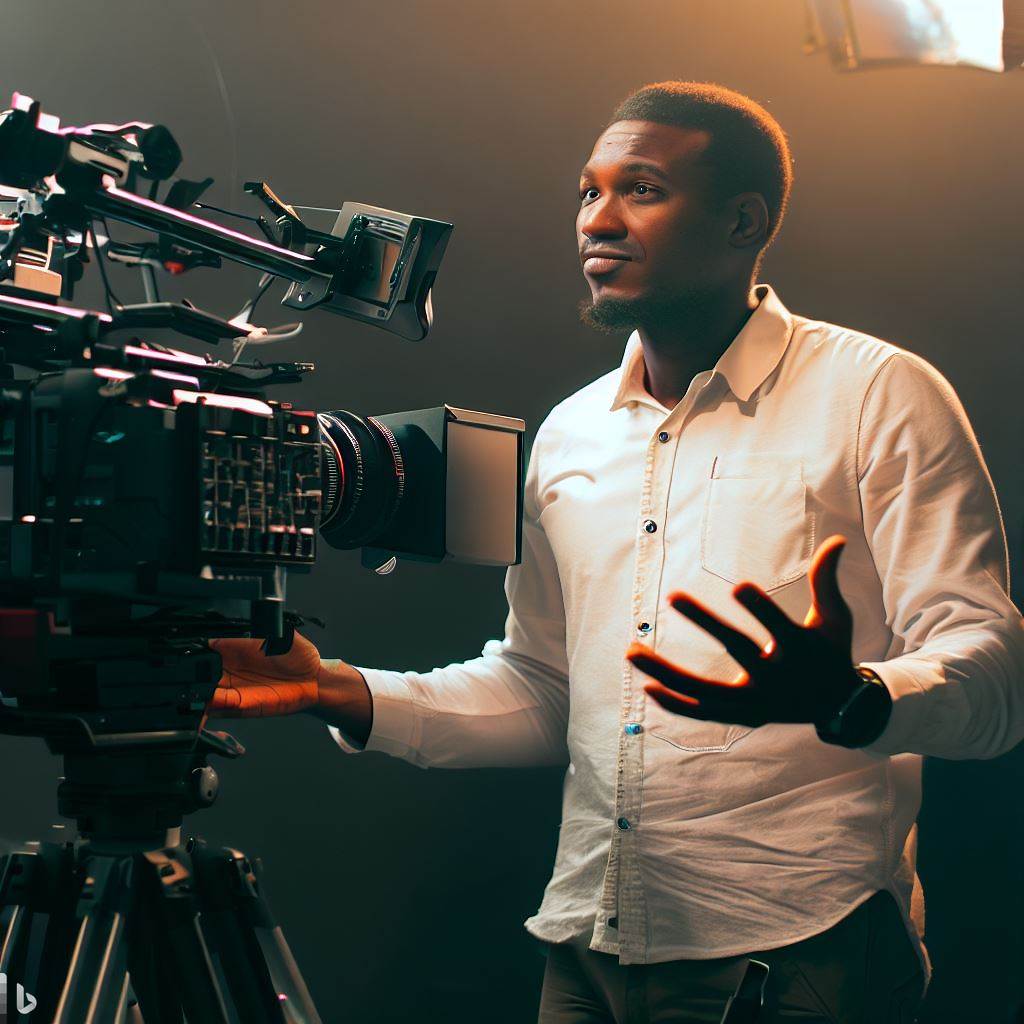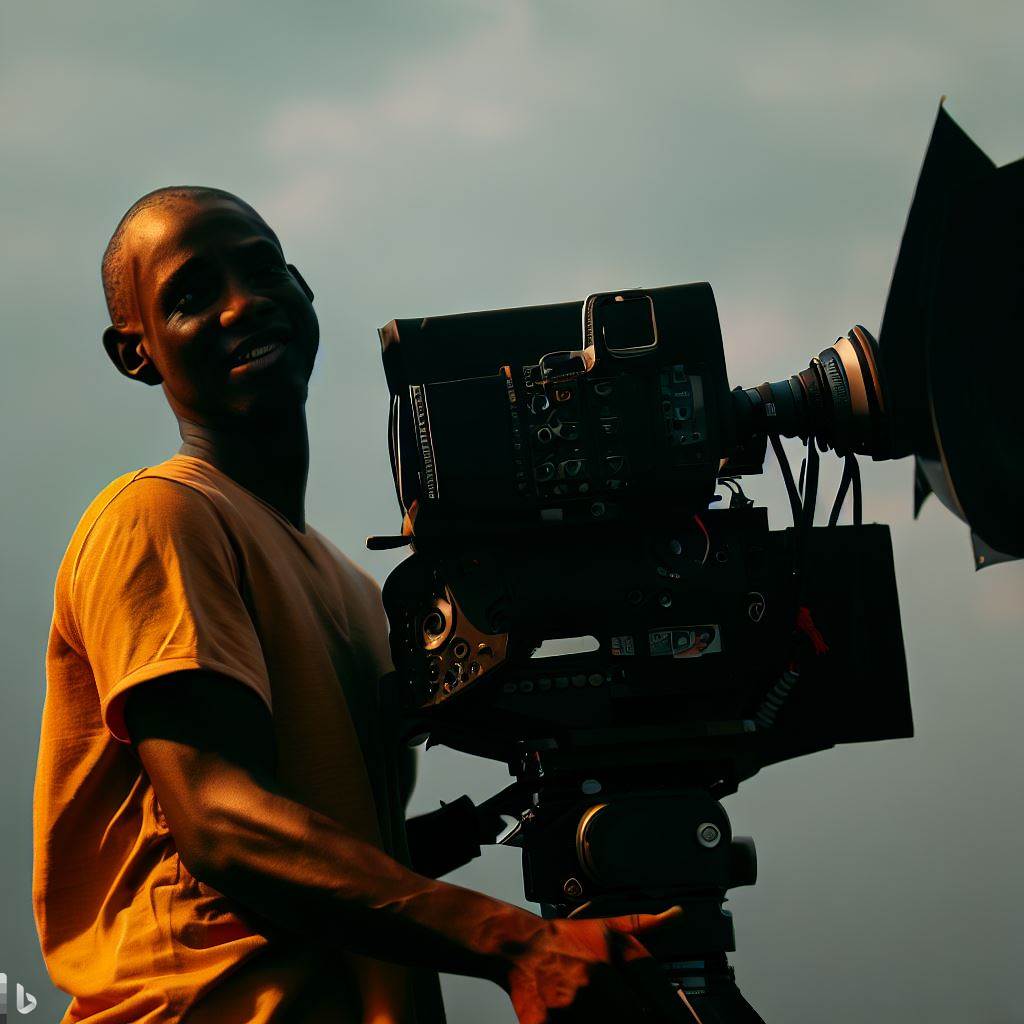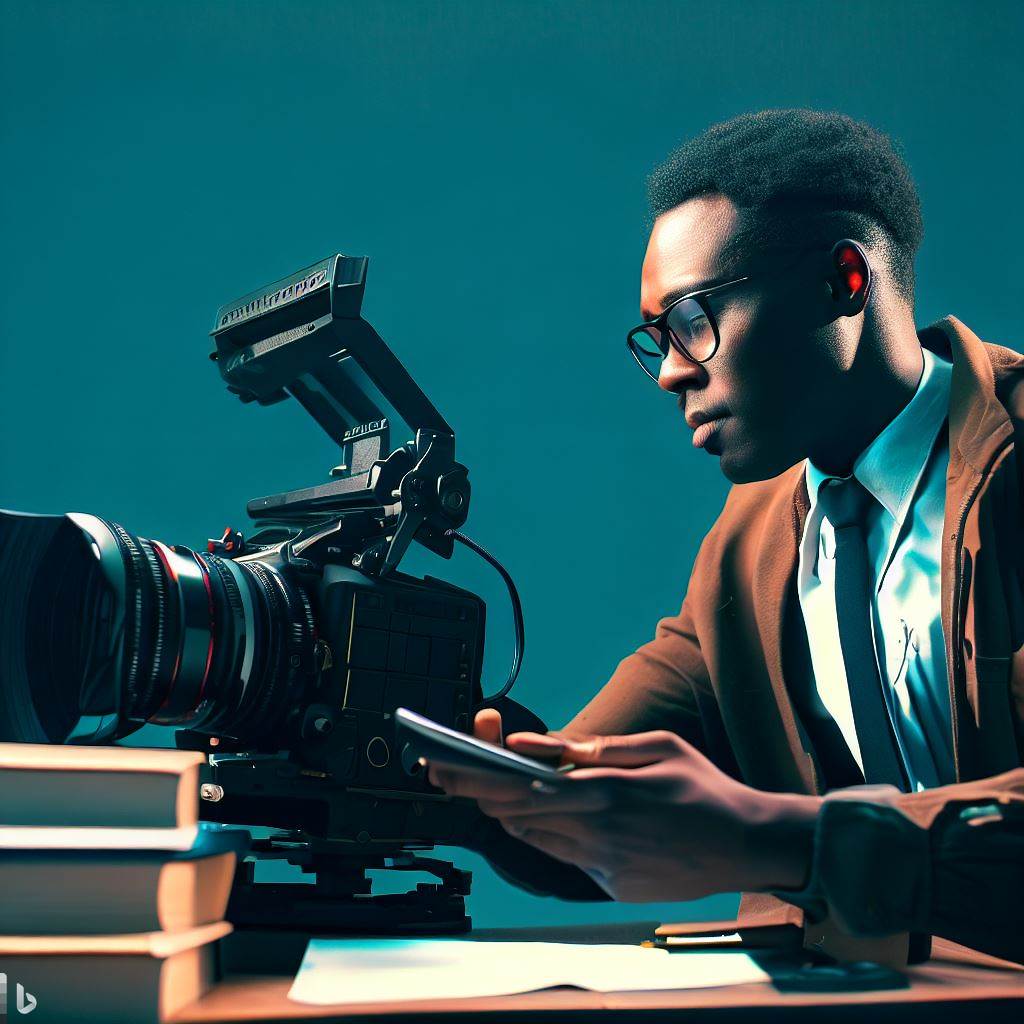Introduction
Importance of cinematography in the film industry
Cinematography plays a crucial role in the film industry, enhancing storytelling through visuals.
Growing prominence of Nollywood
Nollywood, the Nigerian film industry, has gained international recognition and is the second-largest in the world.
Thesis statement: Understanding the role of cinematographers in Nollywood
This blog section aims to explore the significance of cinematographers in Nollywood and their contributions to the industry.
Importance of cinematography in the film industry:
- Cinematography is the visual language of cinema, shaping storytelling and emotional impact.
- It involves camera work, lighting, framing, and composition, translating scripts into captivating visuals.
- Cinematographers are visual storytellers who collaborate with directors to bring cinematic visions to life.
- Their expertise influences a film’s mood, atmosphere, and overall aesthetic.
- Cinematography enhances audience engagement and elevates storytelling, making it an essential film element.
The growing prominence of Nollywood:
- Nollywood, Nigeria’s film industry, has experienced exponential growth.
- It produces thousands of films annually, captivating both local and global audiences.
- Nollywood filmmakers increasingly recognize the significance of high-quality cinematography.
- International collaborations and recognition have placed Nollywood on the global cinematic map.
Thesis statement: Understanding the role of cinematographers in Nollywood:
- Cinematographers are instrumental in shaping Nollywood’s visual identity and storytelling quality.
- They contribute to the industry’s growth and reputation, making Nollywood a cinematic force to reckon with.
What is cinematography?
Definition and explanation
Cinematography plays a crucial role in the creation of films and is often referred to as the art of capturing moving images.
It involves the use of cameras, lighting, and composition to visually convey the story and emotions to the audience.
A cinematographer is responsible for translating the director’s vision into captivating visuals.
They work closely with the director in choosing camera angles, framing shots, and setting the overall look and feel of the film.
Importance of cinematography in filmmaking
The importance of cinematography in filmmaking cannot be overstated. It sets the mood, enhances the storytelling, and brings the script to life on the screen.
It helps create a visual language that engages the audience and enriches their viewing experience.
Cinematographer’s role as the director of photography (DP)
The cinematographer also serves as the director of photography (DP), who oversees all technical aspects of the film’s visual elements.
They are in charge of camera crew, lighting technicians, and other camera-related departments.
Their expertise and creative vision are essential in achieving the desired aesthetic of the film.
Cinematographer’s impact on storytelling and visual aesthetics
One of the primary contributions of a cinematographer is their impact on storytelling.
Through their camera work, they can enhance the narrative by capturing emotions, highlighting key moments, and creating a sense of atmosphere.
Every choice they make, from the choice of lenses to the framing of shots, can greatly influence how the story is conveyed to the audience.
Moreover, a cinematographer’s visual aesthetic choices greatly shape the film’s overall look and feel.
They use lighting techniques, color palettes, and camera movements to create a specific mood or atmosphere.
Whether it’s a gritty urban drama or a vibrant romantic comedy, the cinematographer’s choices add layers of meaning to the story and engage the viewer on a visual level.
In Nollywood, the Nigerian film industry, cinematography has evolved over the years.
With the advancement of technology and access to better equipment, Nollywood films have seen a significant improvement in visual quality.
Cinematographers are now able to utilize their skills to convey powerful narratives and create visually stunning films.
Cinematography is the art of capturing moving images in film. It is a critical aspect of filmmaking that involves the use of cameras, lighting, and composition to visually tell a story.
The cinematographer’s role as the director of photography is essential in achieving the desired visual aesthetic and storytelling goals of a film.
Their impact on storytelling and visual aesthetics cannot be underestimated, as they shape the overall look and feel of the film, engaging the audience on a deeper level.
With the growth of Nollywood, cinematography in Nigerian films has become more sophisticated, resulting in visually captivating and impactful storytelling.
Read: Nigeria’s Animation Industry: Opportunities & Challenges
The role of cinematographers in Nollywood
Cinematographers as visual storytellers
Cinematographers play a vital role in Nollywood as they are responsible for visually conveying the story.
They use their creativity and technical expertise to enhance the narrative through visuals, lighting, and composition.
Their job is to capture the essence of the story and translate it into captivating visuals on screen.
Collaboration with directors, producers, and other crew members
Cinematographers work closely with directors, producers, and other crew members to bring the vision to life.
They collaborate in pre-production to discuss the desired look and feel of the film.
During production, they work together to ensure the visual elements align with the storytelling and overall vision.
Cinematographer’s job responsibilities and tasks
- Lighting and camera operation: Cinematographers are responsible for setting up and controlling the lighting on the film set.
They create the desired mood and atmosphere by strategically placing lights and using different lighting techniques. They also operate the camera, ensuring proper focus, exposure, and framing. - Shot composition and framing: Cinematographers are experts in framing and composing shots.
They carefully consider the placement of subjects, objects, and backgrounds to create visually appealing and meaningful compositions. - Lens and camera selection: Cinematographers choose the appropriate lenses and cameras for each scene.
Different lenses and cameras have unique characteristics that can influence the look and feel of the film, and cinematographers use their knowledge to make informed choices. - Color grading and visual effects: In post-production, cinematographers collaborate with colorists to enhance the film’s aesthetics through color grading.
They also work with visual effects artists to incorporate any necessary visual enhancements seamlessly.
Challenges faced by cinematographers in Nollywood
Cinematographers in Nollywood face various challenges in their work, including budget constraints, time limitations, and technical limitations.
With limited resources, they must be resourceful in achieving high-quality visuals.
The fast-paced production schedules can also put pressure on cinematographers to deliver within tight deadlines.
Furthermore, technical limitations, such as inadequate equipment or limited access to advanced technology, can present additional hurdles.
Cinematographers in Nollywood play a crucial role as visual storytellers.
They collaborate with directors, producers, and other crew members to bring the vision to life.
Their job responsibilities include lighting, camera operation, shot composition, lens selection, color grading, and visual effects.
Despite the challenges they face, cinematographers strive to create captivating visuals on screen that enhance the overall cinematic experience in Nollywood films.
Read: Essential Skills for a PR Specialist in Nigeria
Cinematography techniques in Nollywood
Use of lighting to set the mood and enhance storytelling
- Lighting plays a crucial role in setting the mood of a scene in Nollywood films.
- By manipulating lighting, cinematographers can create a specific atmosphere that complements the story.
- They use techniques like high-key lighting for joyful and uplifting moments and low-key lighting for suspenseful or intense scenes.
- Subtle variations in lighting can evoke emotions and add depth to the storytelling.
- Creative use of shadows and highlights helps to highlight important elements and create a visually captivating experience for the audience.
Creative shot composition and framing to grab attention
- Cinematographers in Nollywood understand the importance of capturing attention through unique shot compositions.
- They carefully frame each shot to draw the viewer’s eye to the subject or convey a specific message.
- The rule of thirds is often employed, dividing the frame into sections to create balanced and visually appealing shots.
- They also experiment with unconventional angles and perspectives to add visual interest and provide a fresh take on storytelling.
- The combination of innovative shot compositions and storytelling techniques engages the audience and keeps them hooked.
Importance of camera movement and stabilization techniques
- In Nollywood films, camera movement is essential for adding dynamism and energy to a scene.
- Cinematographers often utilize techniques like panning, tilting, or tracking shots to follow the action and create a sense of flow.
- Smooth and steady movements help to maintain the audience’s focus and enhance their viewing experience.
- Stabilization techniques, such as using tripods or gimbals, ensure steady shots without unwanted camera shake.
- These techniques contribute to the overall professionalism and polished look of Nollywood films.
Unique visual styles and themes employed in Nollywood films
- Nollywood films showcase a diverse range of visual styles and themes.
- Cinematographers embrace the vibrancy of Nigerian culture, incorporating colorful and rich visuals into their films.
- They often draw inspiration from traditional Nigerian art, fashion, and landscapes, infusing their work with a distinct visual identity.
- Nollywood films also explore different genres, from romantic comedies to action-packed thrillers, each with its own unique visual treatment.
- Through their artistic choices, cinematographers contribute to the overall storytelling and create a signature look for Nollywood.
These unique visual styles and themes collectively contribute to the distinctiveness of Nollywood cinema.
Read: Career Prospects for PR Specialists in Nigeria

Delve into the Subject: Interpreter vs. Translator: Key Differences in Nigeria
Famous Cinematographers in Nollywood
Prominent Cinematographers and Their Notable Works
- Tunde Kelani: Known for his exceptional work in movies like “Thunderbolt” and “Saworoide.”
- Dickson Iroegbu: Notable for his cinematography in “Women’s Cot” and “The Mayors.”
- Teco Benson: Acclaimed for his remarkable cinematography in “Blood in the Lagoon” and “Mission to Nowhere.”
- Lanre Omofaye: Recognized for his outstanding camerawork in “The Figurine” and “Phone Swap.”
- Remi Adefarasin: Renowned for his artistic cinematography in “Mirror Boy” and “Mandela: Long Walk to Freedom.”
Their Contributions to Nollywood’s Visual Storytelling
These cinematographers have revolutionized Nollywood’s visual storytelling by employing various techniques.
- Tunde Kelani demonstrated his mastery of lighting to create captivating moods and enhance emotional depth.
- Dickson Iroegbu employed innovative camera angles to evoke suspense and intensify dramatic moments.
- Teco Benson showcased his expertise in capturing action sequences, creating exhilarating and dynamic visuals.
- Lanre Omofaye utilized composition and color palettes to portray atmosphere and enhance character development.
- Remi Adefarasin captured stunning landscapes and incorporated meticulous framing to enhance the film’s narrative.
Impact of Their Work on the Industry and Their Influence on Upcoming Cinematographers
The work of these famous cinematographers has significantly impacted the Nigerian film industry and inspired upcoming talents.
- Their artistic contributions have elevated the overall quality of Nollywood productions, leading to international recognition.
- Their unique visual styles have served as a source of inspiration for aspiring cinematographers, encouraging creativity.
- These cinematographers have helped revolutionize Nollywood’s storytelling, making it more visually appealing and engaging.
- Their success and influence have boosted the confidence of upcoming cinematographers, showing them that their dreams can be realized.
- They have also paved the way for more recognition of the cinematography profession within the Nollywood industry.
Books or Articles on Nollywood Filmmaking . The contributions of famous cinematographers in Nollywood have greatly impacted the industry, enhancing visual storytelling and inspiring aspiring cinematographers.
Tunde Kelani, Dickson Iroegbu, Teco Benson, Lanre Omofaye, and Remi Adefarasin have transformed the way stories are visually portrayed in Nollywood.
Their notable works have raised the bar for cinematography, improving the overall quality of Nigerian films and bringing them international recognition.
Their influence on upcoming cinematographers cannot be understated, as they continue to inspire and guide the new generation of talented individuals in Nollywood.
Read: Makeup Artists’ Contributions to Nigerian Television & Film
Find Out More: Salaries of Nigerian Cinematographers: A Comprehensive Overview
Conclusion
Cinematographers play a crucial role in Nollywood by enhancing the visual appeal of films.
Their contribution to the success of Nollywood films cannot be underestimated.
It is important for viewers to appreciate and acknowledge the creativity and skills of cinematographers in filmmaking.
Cinematographers are an integral part of Nollywood, as they elevate the visual experience of films and contribute significantly to their success.
As viewers, we should recognize and value the role that cinematographers play in creating captivating imagery and storytelling.
By understanding their contribution, we can better appreciate the artistry and craftsmanship in Nollywood films.
So let’s give credit where it’s due and show our appreciation for the talented cinematographers who bring these stories to life on screen.




